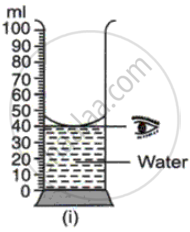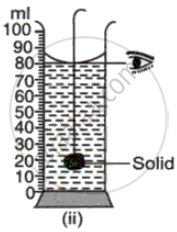Advertisements
Advertisements
Question
Solution


For measurement of an irregular solid by the displacement method using a measuring cylinder.
a. Fill the graduated cylinder with the water.
b. Record the lower meniscus of water and let the value be V1
c. Tie the solid whose volume is to be measured to a strong string and lower it into the water gently.
d. When the object is completely immersed in water, the level of water rises.
e. Note the reading carefully and let the value be V2
f. The volume of the solid, V = V2 - V1
APPEARS IN
RELATED QUESTIONS
In the vernier callipers, there are 10 divisions on the vernier scale and 1 cm on the main scale is divided into 10 parts. While measuring the length, the zero of the vernier lies just ahead of the 1.8 cm mark and the 4th division of vernier coincides with a main scale division.
(a) Find the length.
(b) If zero error of vernier callipers is -0.02 cm,
What is the correct length ?
The pitch of a screw gauge is 0.5 mm and the head scale is divided in 100 parts. What is the least count of a screw gauge?
A screw has a pitch equal to 0.5 mm. What should be the number of divisions on its head so as to read correctly up to 0.001 mm with its help?
Who invented vernier callipers?
A micrometre screw gauge has a negative zero error of 7 divisions. While measuring the diameter of a wire the reading on the main scale is 2 divisions and 79th circular scale division coincides with baseline.
If the number of divisions on the main scale is 10 to a centimetre and circular scale has 100 divisions, calculate
- pitch
- observed diameter
- least count
- corrected diameter.
What do you understand by the following term as applied to micrometre screw gauge?
Sleeve scale
What is the least count in the case of the following instrument?
vernier calipers
